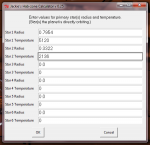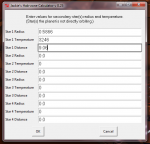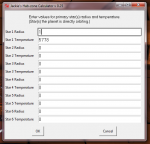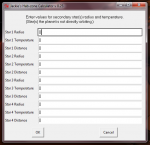Using the tool on multiple-star systems.
This is still experimental and may struggle with more complicated systems, but it certainly works for an example like the one I'll follow here.
The imgur link shows details for the system of IC 1396 Sector VN-R C5-1:
http://imgur.com/a/55vOX
We're going to find the temperatures of the first three rocky planets that are orbiting the binary pair.
For the purposes of the program, the two stars in the binary pair are "primary" stars - those planets are directly orbiting them.
(In the calculation, the distance to these stars is considered to vary.)
The star which is at a greater distance is a "secondary" star - the planets are not directly orbiting it.
(In the calculation, the distance to this star is not considered to vary.)
We need to find the distance between this star and the primaries, and the game doesn't give it directly, so have to measure it from inside the game.
The distance is roughly 4520 light seconds, which is 9.06 au.
Put the values for primary stars in:

And for the secondary star:
(Note that there is a third field for each star on this page, for distance, in this case 9.06 au)

I put the distances for those planets into the next box:

And get the zone display screen:
(Note that this is truncated compared to the usual result, because of the secondary star it doesn't make sense to give distance values far out from the primaries.)

And the results:

The program guessed 416K, 348K and 307K for the planets (they're high metal content, so of "general" type - anything except iceballs and riceballs is "general", albedo 0.35) at 0.27, 0.4 and 0.53 au respectively.
From the imgur album the "real" values are 415K, 349K and 307K, which is accurate enough for most purposes.














